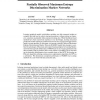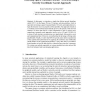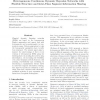70 search results - page 5 / 14 » Bottom-Up Learning of Markov Network Structure |
NIPS
2008
13 years 9 months ago
2008
Learning graphical models with hidden variables can offer semantic insights to complex data and lead to salient structured predictors without relying on expensive, sometime unatta...
PKDD
2010
Springer
13 years 6 months ago
2010
Springer
In this paper, we introduce a simple but efficient greedy algorithm, called SINCO, for the Sparse INverse COvariance selection problem, which is equivalent to learning a sparse Ga...
ECAI
2008
Springer
13 years 9 months ago
2008
Springer
Time is a crucial variable in planning and often requires special attention since it introduces a specific structure along with additional complexity, especially in the case of dec...
ICML
2010
IEEE
13 years 6 months ago
2010
IEEE
Classical dynamic Bayesian networks (DBNs) are based on the homogeneous Markov assumption and cannot deal with heterogeneity and non-stationarity in temporal processes. Various ap...
ICML
2006
IEEE
14 years 8 months ago
2006
IEEE
We present a new unsupervised algorithm for training structured predictors that is discriminative, convex, and avoids the use of EM. The idea is to formulate an unsupervised versi...



